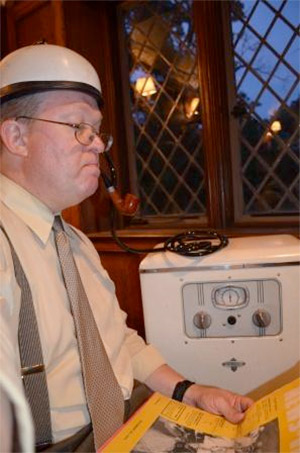Curing baldness in the 1930s
June 21, 2013

Recently, Media Heritage's Mike Martini acquired a 1937, a vintage device promoted as a cure for baldness. Powel Crosley Jr., who was follicly challenged himself, used the device every day. Fred Astaire reportedly had one and it's rumored that George Gershwin used one to ease headaches from his doomed bout with brain cancer.
There's a Crosley Xervac on display in the Museum of Quackery Medicine, but make no mistake, Crosley was no quack. Crosley was not trying to “fool” anyone into buying the device because he truly believed in the science behind the device.
Cincinnati physician Dr. Andre Cueto had spent several years researching the problem of hair loss. The thought was that hair fell out because of a reduction in the circulation of blood vessels under the scalp. There were other devices introduced in the 1920s that relied strictly on suction to stimulate blood flow, but patients were left with red, swollen scalps. Dr. Cueto proposed a machine featuring alternating suction and forced air pressure in brief pulses and contracted with Crosley to produce a prototype. The early feedback was positive and the Crosley Xervac was introduced in 1937 for sale to beauty parlors, barber shops and physicians' offices. In 1938, a smaller and less powerful model was introduced for home consumers.
The device is little more than a belt driven electric motor powering a compressor feeding two identical compression tanks. A regulator alternates between the two tanks, providing short 10-20 second bursts of air or vacuum. A bicycle helmet-sized helmet is connected to the device with a rubber hose and inside the helmet is a rubber membrane that expands or contracts depending upon the air cycle. Keeping the membrane airtight was key. A larger rubber adapter could be used for those with a little hair on the sides. Patients were encouraged to use the device daily for 15 to 30-minutes. The motor is quiet enough that one could read the newspaper or a book, with only a slight “poof” sound in the background.
The recently acquired Xervac runs smoothly but needs a replacement rubber membrane, the original drying up and crumbling away years ago. A rubber swim cap seems to show promise. Meanwhile, the unit was recently on display in Powel Crosley's original bedroom at his Pinecroft mansion—probably the same room where Powel himself donned an Xervac helmet 75-years ago.
Read similar stories: Announcements , crosley
